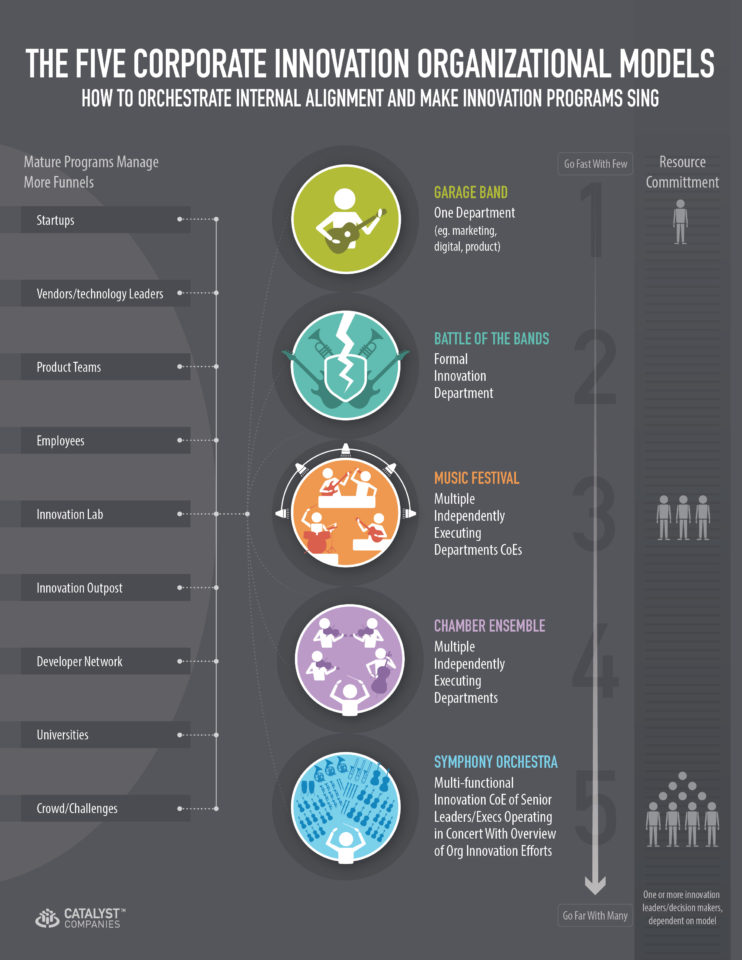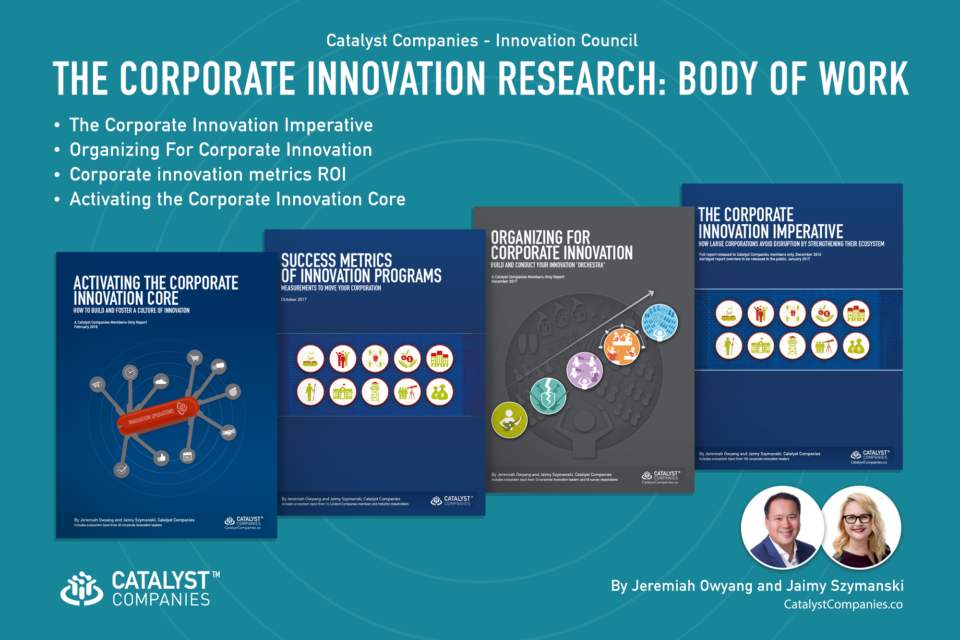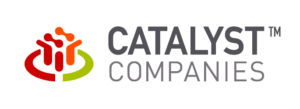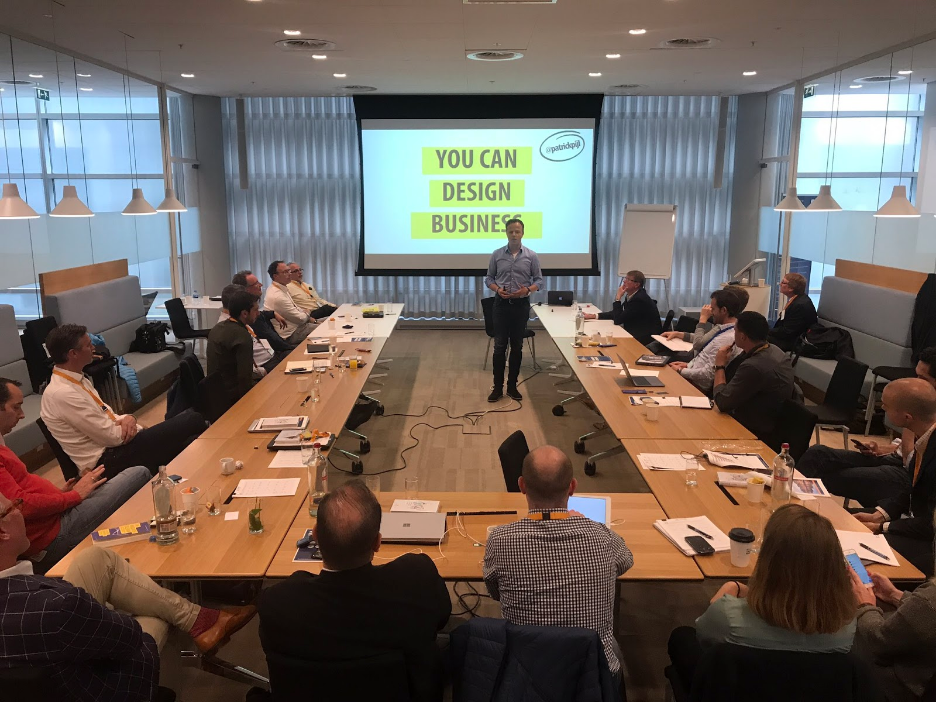
The third report in our series on Corporate Innovation, this report documents how companies have organized for innovation success.
When innovation occurs in multiple pockets throughout a corporation, organizing to thrive and achieve results may seem an arduous––if not impossible!––task. In Catalyst Companies’ new research report, we detail five models that corporations are organizing under to achieve maximum efficiency, ideation, collaboration, and output from their innovation programs.
It’s much like building an orchestral ensemble, wherein a conductor leads multiple musicians and instruments that must act in concert in order to make beautiful music. For each of the five distinct models for corporate innovation, we pair them with easy-to-grasp metaphors that relate to how musicians organize as they mature in their craft. Within each model you’ll learn its pros and cons, who makes decisions, the speed of innovation, and the typical amount of funnels. See the infographic below for a preview of the research:
This members-only report also outlines the top challenges corporations face in organizing for innovation, including a lack of understanding around org model best practices, slow-moving efforts with unclear goals, and departmental or BU “bottlenecks.” Readers will also better understand the types of internal and external funnels that feed innovation efforts, and recommendations in selecting the right model for your company’s size, resources, and innovation vision.
A Sneak Peek at the Most Mature Model: “Symphony Orchestra”

As organizations work their way through innovation program maturity, the ultimate end goal is complete orchestration led by an aligned, visionary group of leaders. We call this model the “Symphony Orchestra.” Multi-functional Innovation CoE of senior leaders from all departments operate in concert with a view of all innovation efforts within the organization. The CoE enables innovation across multiple departments within the company, and members serving on the CoE are also responsible for senior leadership within various corporate groups. Common departments included: marketing/digital, PR, legal, HR, IT, and product. The goal of the CoE is to standardize and scale innovation across the company, providing guidance to efforts that do not yet have dedicated teams or leadership.
Through interviewing nearly 20 senior leaders at large organizations, Catalyst Companies aims to better innovation leaders’ understanding of how to organize their company for rapid innovation. This is best done throughout an orchestration of multiple business units, departments, and teams––all aligning together under common goals and vision for success. For a more robust preview of the report, or to inquire about becoming a Catalyst Companies member, please email Carl Bohlin, Member Success Manager, at carl [at] catalystcompanies.co.


As part of my continued research stream on corporate innovation at Catalyst Companies, an Innovation Council, we’ve completed 3/4 research reports on how large companies are acting more like startups. Here’s some of the findings of how companies formalized innovation programs are shaping up. In this latest research effort, which I partnered with Jaimy Szymanski, looks at how companies are measuring their innovation efforts.
Success of Innovation Programs Depends on Metrics
We’ve identified the most common innovation programs in previous research. However, these programs – and innovation efforts themselves – will fail if metrics are assumed to be equal across all domains. Challenge: Early innovation efforts shouldn’t be measured by revenue –especially when compared to billion dollar product lines. So how should companies measure? Here’s what we found:
Fallacy: Revenue is King
At a high level the typical metric most often discussed at corporate is return on investment (ROI) or what shareholders prefer to hear, revenue. This mindset has, and will, condemn any formalized innovation efforts and undermine the success of innovation leaders themselves. Organizations with successful innovation programs reveal specific metrics for success – which may not include revenue, yet.
Recipe for Success
For any innovation program to mature it must have appropriate metrics aligned at the onset which will ultimately result in the organization’s goal of increased revenue in the long term. The metrics below were gained through qualitative analysis of Fortune 500 companies within the Catalyst Companies Council, as well as outside corporate executives, startup innovators and ecosystem experts.
Programs and their Success Metrics
- Dedicated Innovation Team
- Metrics are indistinguishable between these programs. Ideation is the key for these programs and should be accounted for accordingly.
- Amount of ideas generated to “top of funnel”, incubated, prototyped or meaningfully launched to market.
- Speed and efficiency for each of the aforementioned
- Return on marketing investment or product development expense
- Increase of customer satisfaction through specific metrics like NPS, testimonials or another identified metric
- Effectiveness of a new product or service through measurements like adoption, growth, retention etc
- Percent of leadership time spent on innovation vs daily operations.
Intrapreneur Program
Engagement is key for this program’s success. As such metrics should be assigned to measure overall involvement. Things like:
- Employee participation, trained or engaged
- Role or rank of participants
- Amount of workshops, training and attendance
- Amount of ideas submitted or generated
- Amount of ideas generated by innovation sponsors BU as compared to others
- Conversion rates of ideas
- ROI from ideas to market
- Efficiency of time to market
- Customer satisfaction
Open Innovation
Allowing external parties into corporate provides a symbiotic relationship which must be measured. Participating parties look to their benefits of things like potential funding or corporate support. Corporations must measure;
- Amount of ideas generated or participation through votes, comments or engagement
- Quality of start-ups participating in challenge/contest
- Amount of ideas that generate minimum viable product (MVP), measured per quarter
- Amount of ideas to production
- Efficiency from idea to MVP to production
- Development costs MVP or POC
- ROI and use of products resulting from challenge, contest or program
Metrics Tell Your Story and Prove Your Worth!
Aligning the innovation groups goals to corporate initiatives has never been more important. Revenue cannot be the only measurement, or the group and its leaders & personnel, will fail miserably. Identification of metrics at the start – including desired business outcome – will help determine which program is best suited for your organizational goals.
To learn more about this research, please send me an email at jko@cataylstcompanies.co
We’re excited to announce our rebranding to Catalyst Companies. Council members drive the research direction and discussion agenda of the council – technologies impacting business model change. We have now expanded coverage to include Innovation (Groups/Structures/Metrics), Blockchain, Collaborative Economy and Autonomous World (Transportation, Drones, AI, Various Realities).
Three Innovation Topics to Pay Attention to that are Spurring Council Discussion:
Physical World Events Become Virtual
Everyone is looking to improve the customer experience, and we know technology is changing the way customers engage. Starting in 2018, the NBA will be making big moves in the way customers access events. Fans will be able to experience NBA games however they prefer to view, anything from courtside like a celebrity to high above the court for full viewing. Think of the implications for stadiums, concessions, traffic, tickets and more…Read more about the Turner Sports and Intel Partnership
Autonomous Ownership
More and more auto manufacturers are accepting and investing in the new business models of consumers not owning vehicles (or other products). As discussed at previous council events the BMW DriveNow program is profitable. Will manufacturers be the providers of car sharing services, will UBER, Lyft, and Waymo continue to exist when autonomous vehicles have fully emerged from manufacturers? UBER and Volvo recently upped their partnership through UBER’s order of 24K Volvos – worth an anticipated $1.4B. The move does not restrict UBER to Volvo-only vehicles but will increase the automaker’s presence in the autonomous world…Read more about the partnership here
Innovation’s Emerging Themes
Three themes emerge as technology proliferation takes hold – Superhumans, Fluid Organizations and Enlightened Ecosystems. To keep the council pure peer to peer, Catalyst founder Jeremiah Owyang has launched a new initiative, Kaleido Insights, with a team of seasoned analysts to help organizations with deeper engagements. This research looks at any technology holistically across the three themes and has a few key diagrams showing characteristics that are worth printing and discussing internally. Read more about these Three Macrotrends Impacting the Journey to 2030.

by Jeremiah Owyang, founder of Catalyst Companies
I’ve some exciting news to share. Our conversations and coverage have expanded, and so has our name. Four years ago, we launched the council based on the Collaborative Economy topic, a dominant trend. Since then, more trends have emerged, and we’ve seen a growth in member topics around a variety of trends.
Through our members guidance, we have expanded council topics to include;
- Corporate innovation
- Autonomous world (includes various realities, AI and Drones)
- Blockchain
- and more as our members guide.
As such, I am excited to announce a rebranding to Catalyst Companies on November 16th.
The logo was a member favorite, so we’ve kept the logo mark. We’ve just changed the word “Crowd” to “Cataylst” using the same font –and obtained a new domain.
Our members are catalysts within their respective organizations, driving change and leading innovation efforts. Through Catalyst Companies we can engage, learn and share with peers.
If you have any questions or would like to learn more, please let me know directly.
You can reach me at jko@catalystcompanies.co
Do you have proven success measures for your corporate innovation programs? If so, we’d like to interview you for an upcoming Catalyst Companies report that I’m working on with Jaimy Szymanski
The report will showcase how companies are measuring success for each of the 10 corporate innovation programs established in previous Catalyst Companies research. Looking internally and externally, we’ll examine how companies are determining the right objectives and key performance indicators (KPIs) to align innovation program efforts with over-arching corporate and departmental goals.
This research will also delve into the challenges faced in measuring success, software and other tactics used for data analysis, and provide recommendations for aligning current digital, customer service, and product development metrics to fit with innovation programs. Readers will finish the report with a better understanding of how their innovation program(s) can contribute to greater, measurable organizational growth.
Interviews last approximately 30 minutes, and nothing will be shared without your approval. The report will be available in full to Catalyst Companies members, and partially to the public.
Ideal interview candidates fulfill one or more of the following criteria:
- Be in an innovation position (senior leadership preferred) at a large corporation, or otherwise contribute to company business model changes,
- Ideate new products or features, or improvements to existing products and services,
- Build new customer experiences brought forth by disruptive technologies,
- Responsible for strategy and execution of one or more corporate innovation programs, internal or external,
Do you fit the bill? Please email me at Jeremiah@CrowdCompanies.com for more information. Thank you in advance for contributing to our research that will benefit all corporate innovators.
By Carl Bohlin with Jeremiah Owyang
Washington DC was the recent stop for The Catalyst Companies Innovation Council Spring Summit. Our Council Members – Innovation Leaders from cross vertical industries like Energy, Entertainment, Health and Beauty, Hospitality, Insurance and more – gathered at the AARP Innovation Hatchery, for a lengthy day of discovery, insight and innovation best practices.
Our day and a half events are designed to have a mixture of interaction, inspiration and useful content from other innovation peers. We’re often hosted at our members’ locations, this time at AARP.
Day 1: Where we explore various venues in the ongoing effort of innovation. We started our day at 1776, a startup incubator. Members had the opportunity to explore the facilities, learn about engagement between 1776 and the start-ups and how they leverage the Union Platform (assisting startups with connections, education, investments, resources and partners). We also learned more about the Challenge Cup competition which is a 75 city competition to identify promising start-ups. Members also had the opportunity for discussions with start-ups and the experiences they had while working with 1776.
Local Motors was the next stop on the excursion. Cool and wow come to mind as wrap up words. For those that don’t know, Local Motors produced the world’s first 3D printed car, Strati – talk about a game changer for auto manufacturing! They also produce the more commonly known autonomous shuttle, Olli. We hear often about advancements in autonomous driving but not as much on the manufacturing side – imagine printing a custom vehicle with electronics embedded into the body, replaceable body parts (and reusable materials) that know when wear, or damage from an accident requires attention to only that specific part which can be manufactured and sent direct for replacement.
We also learned of the open development platform Launch Forth. Launch Forth, a SaaS platform enabling the crowd to participate in rapid, open development, often through prize monies. Examples provided included Rally Fighter as the first co-created vehicle, GE’s Opal nugget ice maker (reducing time to market by as much as 44 months while gaining critical customer insights) and Dominos use of the crowd for its new pizza delivery vehicle, DXP. The HP Mars project will be kicking off soon with the crowd participating in making a dream into reality.
The council gathered afterward for private dinner discussion and reflection.
Day Two: AARP hosted Catalyst Companies members at their innovation lab, The Hatchery. The openness and aesthetic nature of the lab further enhanced Council discussions.
Members of the council presenting case studies of innovation included AARP and Comcast. Members were also treated to insights and learnings from NASA. Blockchain was also a topic with Jeremy Epstein providing his insight along with our own Jeremiah Owyang discussing the latest member directed research on Blockchain.
Common threads of the tours, presentations and discussions included;
Policy is good: Policy provides a starting point to build from. Everyone has one and should look at ways to enhance their policy to allow flexibility to foster innovation. If the federal government can overcome obstacles it can be done in large organizations. Persistence and flexibility with an “eye on the prize”.
Importance of Prototyping: Early, often and iterative. Right from the first day we discussed the importance of prototyping – along with what to do and more importantly not do. Don’t let design principles and flow overtake the importance of the prototyping and incorporating end user feedback.
Start Small: Big budgets set expectations of big delivery. Start small with an appropriate budget to ensure the solution is heading the right direction; if it veers off course, it should be killed quickly. When moving forward, improve it iteration by iteration to meet expectations.
Prizes Matter: From government to private entities we shared stories on the importance of prizes to engage the audience. If you want to get something done at a lower cost, and have users incorporating what they want, engage internal, external or all channels of the crowd. As one speaker mentioned, Gold, Good, Guts and Glory are the reasons people donate their time.
Blockchain IS coming: Although case studies are few they do span across industries. While many feel it’s off too far in the future, start-ups (or barbarians ready to tear down the walls said one) are working intently. When the technology is ready it will have far ranging implications for the middle layer of transactions.
Large Organizations are like Groupies: The allure of the start-up culture and nimbleness will always continue to nip at the heels of large entities – rightly so as some have the ability to completely smash the current business model. There are various forms of engagement from incubator, accelerator, innovation labs, partnerships, prizes, competition etc. Large organizations need to stay vigilant and fully vet how they view, engage, incorporate or partner with this external community. If done right huge success can be had by all, but external development brought into the “mother ship” can cause real angst.
By Jeremiah Owyang and Jaimy Szymanski
Blockchain technology has the potential to upend the way every industry manages its information and data, not only financial services.
Imagine being able to track shipments through your supply chain with ease, down to the individual package or even component level. Or, executing a contract with a vendor without the need for an intermediary auditor. Blockchain can even help verify materials and food sourcing to ensure health and ethical standards are maintained.
Though most who are familiar with the technology equate it to Bitcoin, opportunities abound in other verticals in effectively storing transaction, customer, and supplier data in a transparent, unchangeable ledger online. Any relationship that depends on third-party maintenance, or those that require multiple data sources to fulfill customer expectations for cohesive experiences, can be improved by blockchain applications.
In the latest Catalyst Companies market projection report, “The Business Models of Blockchain” (available to our innovation council members only), we explore how blockchain technology enables transparency and accountability of assets in every industry through shared, immutable ledgers. These impacts are outlined at a high level in the infographic below. (Click here or on the image for the hi-res version to share with your networks.)
The potential industry disruptions included in the infographic are:
Legal: “Smart contracts” stored on the blockchain track contract parties, terms, transfer of ownership, and delivery of goods or services without the need for legal intervention.
Supply Chain: By utilizing a distributed ledger, companies within a supply chain gain transparency into shipment tracking, deliveries, and progress among other suppliers where no inherent trust exists.
Government: Blockchain offers promise as a technology to store personal identity information, criminal backgrounds, and “e-citizenship,” authorized by biometrics.
Energy: Decentralized energy transfer and distribution are possible via micro-transactions of data sent to blockchain, validated, and re-dispersed to the grid while securing payment to the submitter.
Food: Using blockchain to store food supply chain data offers enhanced traceability of product origin, batching, processing, expiration, storage temperatures, and shipping.
Retail: Secure P2P marketplaces can track P2P retail transactions, with product information, shipment, and bills of lading input on the blockchain, and payments made via Bitcoin.
Healthcare: Electronic medical records stored in a blockchain, accessed and updated via biometrics, allow for the democratization of patient data and alleviate the burden of transferring records among providers.
Insurance: When autonomous vehicles and other smart devices communicate status updates with insurance providers via the blockchain, premium costs decrease as the need for auditing and authenticating data vanishes.
Travel and Hospitality: Passengers store their authenticated “single travel ID” on the blockchain for use in lieu of travel documents, identification cards, loyalty program IDs, and payment data.
Education: Educational institutions could utilize the blockchain to store credentialing data around assessments, degrees, and transcripts.
As part of our research coverage on disruptive technologies, blockchain aligns with our prior research on the Collaborative Economy, where technologies strengthen P2P relationships to bypass central institutions. Additionally, blockchain technologies will be harnessed by autonomous technologies, enabling machine-to-machine transactions.
Want to stay updated with our latest content, and research? Sign up for our newsletter. If you work for a large corporation, become a Catalyst Companies member.
By Jeremiah Owyang and Jaimy Szymanski
Corporations are struggling to keep pace with technology trends, but the real innovation challenge lies in their internal culture. In other words? The “tech issue” isn’t an issue! According to our recent survey, the top challenge companies face in corporate innovation is fostering an internal culture of experimentation and innovation (57%).
Truly innovative companies focus on setting a foundation with the right people and empowering them, as well as governance, before large investments take place that lack direction, resources, or goals. These corporations are diversifying their hiring strategies in the face of rapidly disruptive technologies, consumer adoption of related trends, and the advent of new business models that emerge from the two. In order to remain competitive in an environment that embraces rapid startup innovation, corporations must focus both internally (on existing talent) and externally (on acquiring new talent) to build their talent pools.
In our latest Catalyst Companies report available on Slideshare, “The Corporate Innovation Imperative: How Large Corporations Avoid Disruption by Strengthening Their Ecosystem,” we uncovered three distinct manners in which the most mature corporations approach hiring innovative employees: Intrapreneurship Programs; Technology Education / University Partnerships; and Startup Acquisitions. In the full report available to Catalyst Companies members, you’ll also find case examples from corporations that have found success.
Intrapreneur Program
Internal employees — dubbed “intrapreneurs” — are given a platform and resources to innovate. These programs invest in employees’ ideas and passions to unlock everything from customer experience improvements to product enhancements and full-blown internal startups that are then launched from within the company. Intrapreneurship programs are an effective and cost-efficient way to surface ideas and shape your business without the need to purchase expensive startups or hire external talent or vendors. They enable rank-and-file employees to contribute to a culture of innovation.
Technology Education / University Partnership
Through an educational partnership, corporations can tap into new university graduates, early-stage projects and companies, and the network of an established educational institution. In addition to traditional universities, there are new private versions opening up that are dedicated solely to technology training, like Galvanize and General Assembly. Partnering with educational institutions provides corporations with a first look at breaking technologies and how they’ll impact our culture through an academic lens. These partnerships are an effective way to secure new talent about to enter the marketplace.
Startup Acquisition
Rather than build innovation from the inside, some corporations acquire successful startups and integrate. While expensive, the startup is often already successful, and the acquisition can help the startup scale further. Acquiring startups showcases a corporation’s focus on the future and evolving its products, services, and customer experiences to meet new expectations. Stanford also shared with us that some companies experiencing a hard time hiring software talent have used “acqui-hiring” to bring people into the company. It can be a useful way to acquire talented employees along with new technologies.
Advanced Companies Focus on People Before Programs
Corporations that retool their hiring strategy to meet the evolving talent needs of their innovation programs will reap the rewards of crafting an innovation team (or “center of excellence”) that has the expertise, experience, and drive to incite change. Our survey also uncovered that dedicated innovation teams (79%), innovation centers of excellence (61%), and technology education / university partnerships (54%) are the most commonly deployed corporate innovation programs (see figure below). This shows that companies are first focusing internally on building the right teams, getting governance and processes in place, and educating current and new employees on emerging technologies before spending time and resources on rolling out external programs or investing in the startup scene.
Other best practices from advanced organizations include:
- Mature corporations understand that an innovation program is only as good as the employees behind it. Follow in the footsteps of corporations like Verizon, which have multiple innovation teams in various business units, each with talented members dedicated to both ideation and execution. This helps them move efficiently to prototype and launch new innovations.
- Also focus on talent retention, as there’s a commonplace and ever-present threat that your best and brightest will be poached (or, at the very least, approached) by competing corporations or startups. Leaders at mature organizations consistently ask themselves, “Are we doing enough to keep our most innovative employees happy?” The most effective incentives tie employee progress on innovation KPIs directly to pay structure.
- Finally, we found that the most advanced companies receive a dedicated budget from the CEO to ensure company-wide support of innovation as a long-lasting cultural mandate––even if the company is not performing well financially.
Alongside the BMW Group’s envisioning of the next 100 vehicles, Catalyst Companies Founder Jeremiah Owyang helped express the motivation for corporate cultural transformations that shift vehicle manufacturers into mobility service providers in order to fit the mold of the future that young people expect rather than engineer tomorrow based on yesterday. That future ought to blend technology and emotion into what BMW has codified as its ACES: vehicles that are autonomous, connected, electrified, and shareable.
Take, for example, the MINI, a shared, self-expressive “Facebook on wheels.” The current challenge is meeting such a vision with the standards expected by today’s young corporate citizens. But with radical, creative innovation from passionate workforces, success here would steer mobility toward becoming a service that creates freedom — with no driver’s licenses — and moves us to the connected world we want.
Learn more from the event on the following video:
BMW: In Dialog with the Future
How to share with just friends.
Posted by Facebook on Friday, December 5, 2014
by Carl Bohlin, Sr. Member Sucess Manager

Council Members gathered in Amsterdam for 1.5 days to discuss innovation at our first European Summit of 2017. The group started the experience with excursions to ShareNL and Startupbootcamp prior to our Member Dinner.

Amsterdam is at the forefront of the sharing economy and environmentalism efforts. Our excursion started at ShareNL where they discussed assisting through education, and start-up guidance. Members also participated in an interactive discussion with start-ups to understand more the opportunities brands could have with them. Council members challenged startups to combine and collaborate across sharing platforms to enhance the user experience and value. We also discussed how consumer adoption of the sharing lifestyle and respective platforms was more of a priority to startups than regulations.

Startupbootcamp provides guidance, structure and a formalized process for innovation. Bootcamps are designed for start-up’s and corporate training programs. Start-ups engaged in the program provide equity to Startupbootcamp but they are also provided a stipend for living expenses for the three month program to ensure they can focus on completion. Survival rates are ~80% for the start-ups who have completed the program. Regardless of the attendee origin, Startupbootcamp strives to push attendees for the “why” and to maintain a customer centric view at all times. For the corporate program they include a mandatory 1 day session for C level executives to ensure greater success when employees finish the program and are integrated back into corporate.

Philips hosted Catalyst Companies members for the full day of interactive sessions. The sessions included two thought leaders, Rik Vera, CEO of Nexxworks and Patrick van der Pijl, CEO Business Models Inc. We also had deep dive presentations from fellow members at Philips, Achmea, Swisscom, and Leroy Merlin which showcased their Innovation efforts, and allowed discussions for best practice.
Through the day common elements or trends emerged from the leaders across all presentations/discussions including: Customer Centricity, Data, Strategy & Communication and Culture.
Customer Centricity
This may seem obvious but know who the actual customer is and the “why”. Get outside and observe, ask and learn – it’s really fun too! Ensure the product, innovation or corporate strategy aligns to the end customer. Gain insights by connecting the dots of your internal and external parties, possibly creating something new. One example of really knowing the end customer provided a potential 60M in savings. We also discussed the customer voice/actions being one of the best sales tools.
Data
Data and management continues to be a significant trend. For monitoring, the right or agreed metrics being the critical component. One member shared their digital footprint for social monitoring and how they could communicate information back to product owners in near real time. Autonomous, Artificial Intelligence, Chatbots and other technologies will only increase data to be reviewed – choose metrics wisely and be sure agreement exists on measurements.

Strategy & Communication
Nimble strategy cannot be overlooked. Innovation leaders discussed how some are gaining traction within the board level to increase awareness and improve communication. Some have annual meetings to revive mission and vision to see where they are . With customer and technology advancements strategy has to be fluid and changing – one presenter shared time spent may be 70% today, 20% tomorrow and 10% longer term. Metrics also need to be highly communicated and agreed in advance so that Innovation is not bound to KPI’s meant for traditional business functions. Failure should also be open and okay to learn fast, adapt and change – doing something and learning is better than nothing.
Culture
We all know the important role culture plays within any organization. We have observed in our research the frozen middle layer and executive acceptance of Innovation. Members at this meeting shared insights to how they are dealing with change – forcing C level participation at bootcamps, open communication on metrics, involving HR through all levels of the organization to require change and unlearn old methods, pushing back on ROI or unknown goals during initiatives. Open the doors to outside your industry (Value of the Council). Trust – in the team innovating to do the right thing. One member shared 8B in new revenue was from products not in the market 8 yrs ago. Visual representation was also discussed as a tool to assist with a new project or initiative and gather support.
It’s great to see and hear the member challenges and opportunities. To me, it’s especially gratifying when I hear afterwards how members return to their organizations with concrete steps to improving innovation learned from our meetings. Such a fantastic group!








